Industry Research Project: Fresh Farm Vegan Restaurant Analysis
VerifiedAdded on 2021/04/17
|53
|11421
|89
Report
AI Summary
This industry research project examines the market feasibility and profitability of The Fresh Farm, a new vegan and sustainable restaurant in Darlinghurst, New South Wales. The research explores the challenges of launching an innovative business, particularly within the hospitality industry, and investigates consumer attitudes towards veganism, sustainable practices, and vertical farming. The study employs both survey and interview methodologies to assess market potential, analyze the competitive landscape, and evaluate financial viability. The report provides a comprehensive overview of the restaurant's concept, including its use of vertical farming and sustainable practices, along with a SWOT analysis, marketing mix (7Ps), and competitor analysis. It identifies potential gaps in the market and offers recommendations based on the findings, ultimately concluding that the market feasibility and profitability are moderate due to the novelty of the concept. The research also includes an executive summary, table of contents, literature review, research methodology, findings, and conclusions, along with appendices containing the survey questionnaire and interview transcripts.
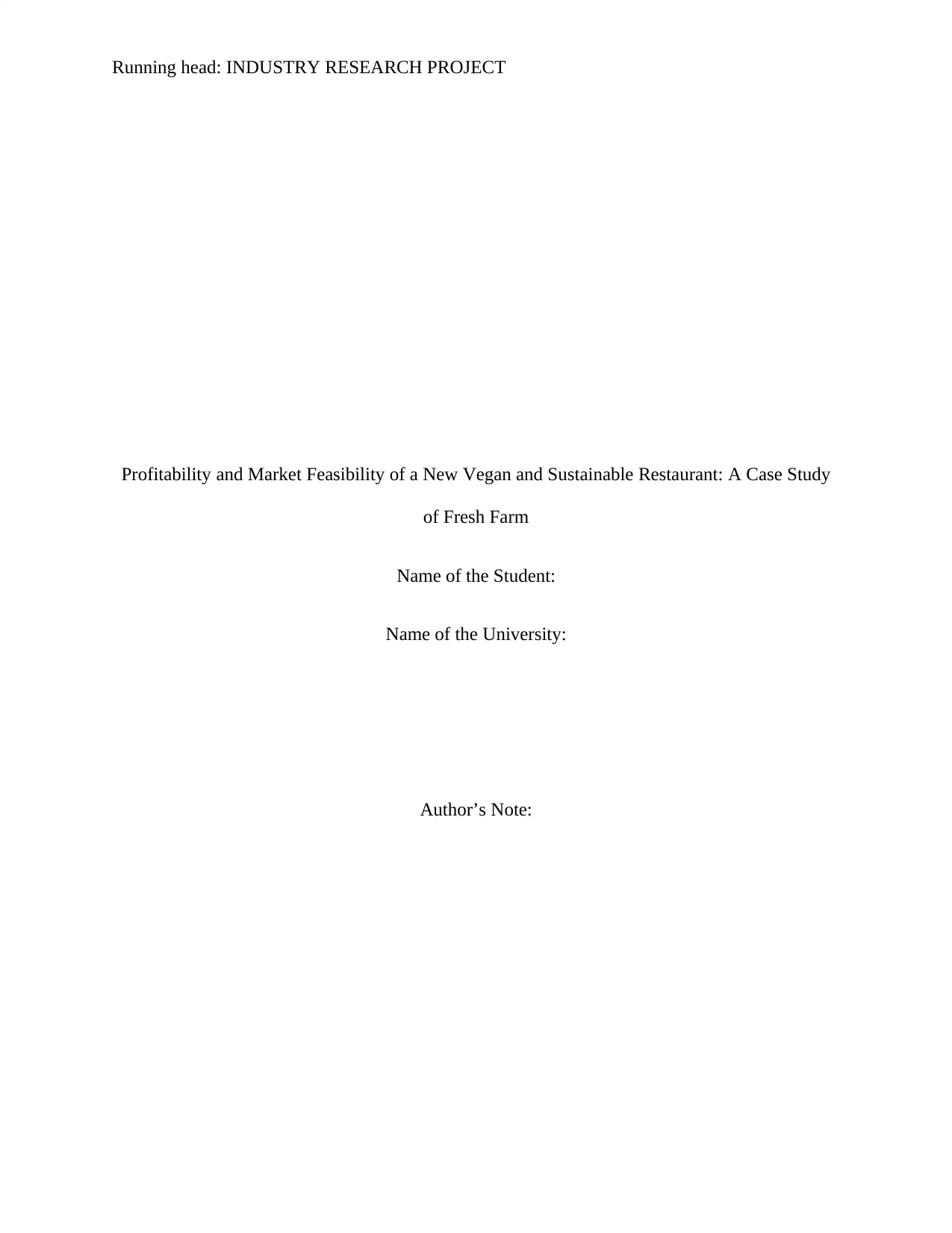
Running head: INDUSTRY RESEARCH PROJECT
Profitability and Market Feasibility of a New Vegan and Sustainable Restaurant: A Case Study
of Fresh Farm
Name of the Student:
Name of the University:
Author’s Note:
Profitability and Market Feasibility of a New Vegan and Sustainable Restaurant: A Case Study
of Fresh Farm
Name of the Student:
Name of the University:
Author’s Note:
Paraphrase This Document
Need a fresh take? Get an instant paraphrase of this document with our AI Paraphraser
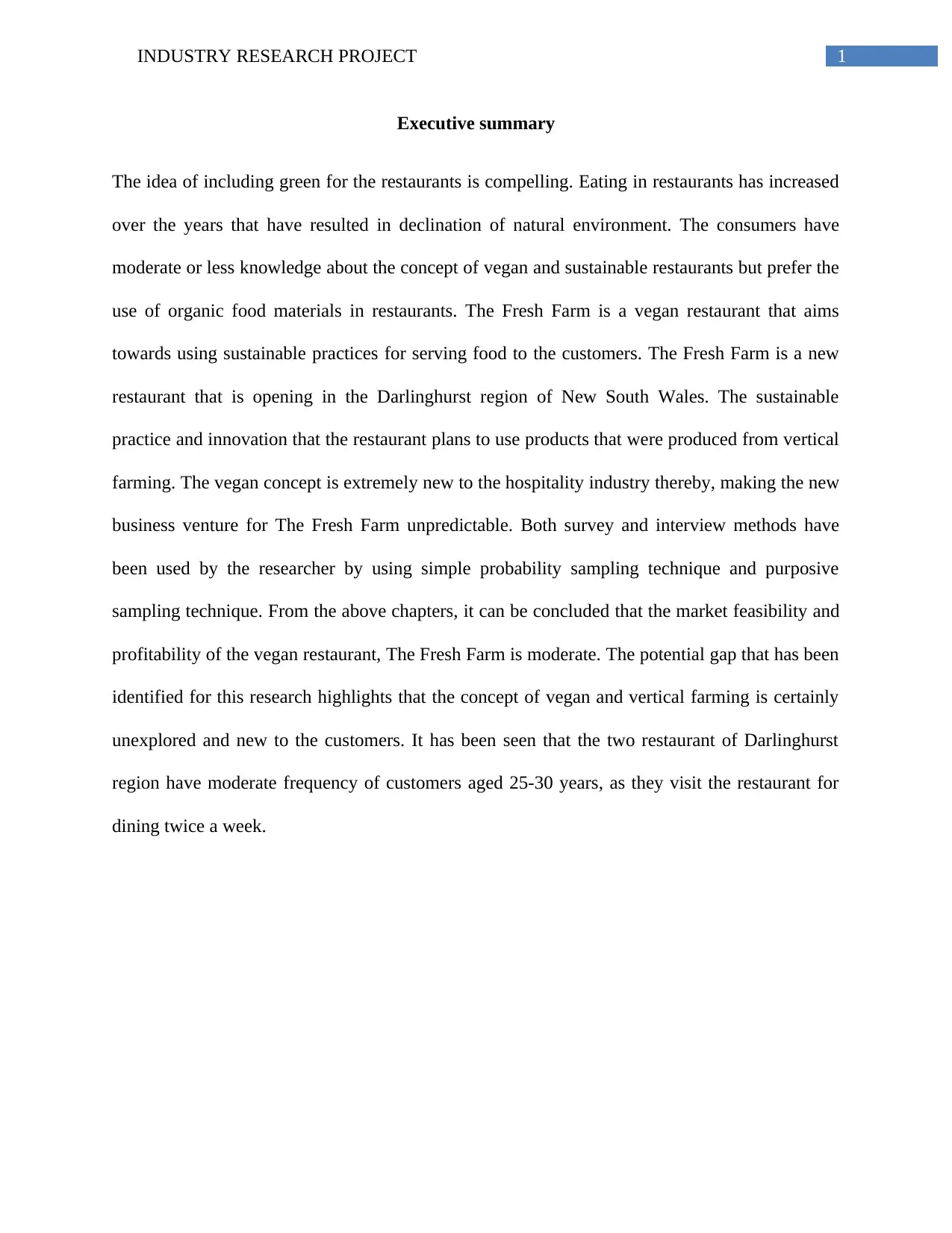
1INDUSTRY RESEARCH PROJECT
Executive summary
The idea of including green for the restaurants is compelling. Eating in restaurants has increased
over the years that have resulted in declination of natural environment. The consumers have
moderate or less knowledge about the concept of vegan and sustainable restaurants but prefer the
use of organic food materials in restaurants. The Fresh Farm is a vegan restaurant that aims
towards using sustainable practices for serving food to the customers. The Fresh Farm is a new
restaurant that is opening in the Darlinghurst region of New South Wales. The sustainable
practice and innovation that the restaurant plans to use products that were produced from vertical
farming. The vegan concept is extremely new to the hospitality industry thereby, making the new
business venture for The Fresh Farm unpredictable. Both survey and interview methods have
been used by the researcher by using simple probability sampling technique and purposive
sampling technique. From the above chapters, it can be concluded that the market feasibility and
profitability of the vegan restaurant, The Fresh Farm is moderate. The potential gap that has been
identified for this research highlights that the concept of vegan and vertical farming is certainly
unexplored and new to the customers. It has been seen that the two restaurant of Darlinghurst
region have moderate frequency of customers aged 25-30 years, as they visit the restaurant for
dining twice a week.
Executive summary
The idea of including green for the restaurants is compelling. Eating in restaurants has increased
over the years that have resulted in declination of natural environment. The consumers have
moderate or less knowledge about the concept of vegan and sustainable restaurants but prefer the
use of organic food materials in restaurants. The Fresh Farm is a vegan restaurant that aims
towards using sustainable practices for serving food to the customers. The Fresh Farm is a new
restaurant that is opening in the Darlinghurst region of New South Wales. The sustainable
practice and innovation that the restaurant plans to use products that were produced from vertical
farming. The vegan concept is extremely new to the hospitality industry thereby, making the new
business venture for The Fresh Farm unpredictable. Both survey and interview methods have
been used by the researcher by using simple probability sampling technique and purposive
sampling technique. From the above chapters, it can be concluded that the market feasibility and
profitability of the vegan restaurant, The Fresh Farm is moderate. The potential gap that has been
identified for this research highlights that the concept of vegan and vertical farming is certainly
unexplored and new to the customers. It has been seen that the two restaurant of Darlinghurst
region have moderate frequency of customers aged 25-30 years, as they visit the restaurant for
dining twice a week.
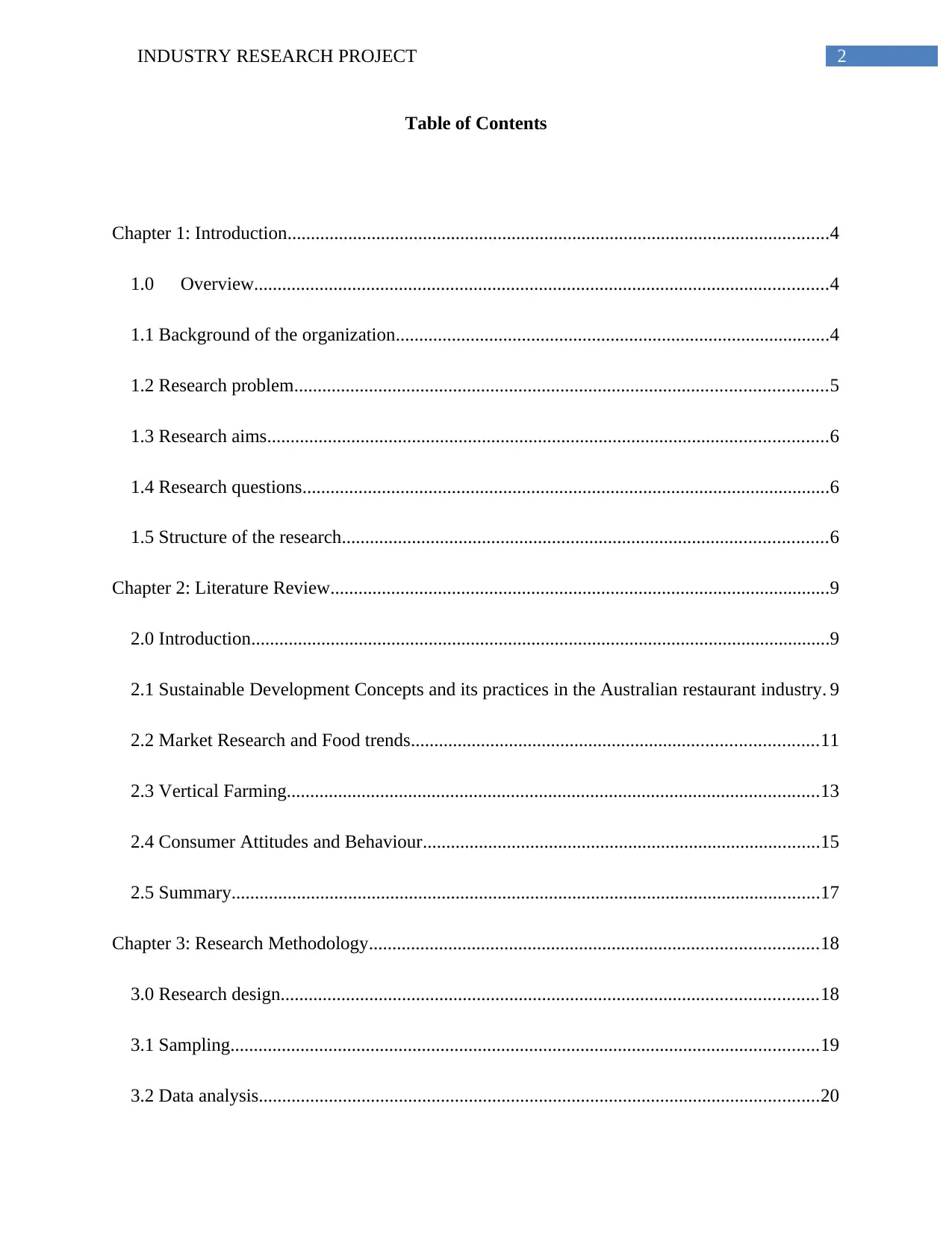
2INDUSTRY RESEARCH PROJECT
Table of Contents
Chapter 1: Introduction....................................................................................................................4
1.0 Overview...........................................................................................................................4
1.1 Background of the organization.............................................................................................4
1.2 Research problem..................................................................................................................5
1.3 Research aims........................................................................................................................6
1.4 Research questions.................................................................................................................6
1.5 Structure of the research........................................................................................................6
Chapter 2: Literature Review...........................................................................................................9
2.0 Introduction............................................................................................................................9
2.1 Sustainable Development Concepts and its practices in the Australian restaurant industry. 9
2.2 Market Research and Food trends.......................................................................................11
2.3 Vertical Farming..................................................................................................................13
2.4 Consumer Attitudes and Behaviour.....................................................................................15
2.5 Summary..............................................................................................................................17
Chapter 3: Research Methodology................................................................................................18
3.0 Research design...................................................................................................................18
3.1 Sampling..............................................................................................................................19
3.2 Data analysis........................................................................................................................20
Table of Contents
Chapter 1: Introduction....................................................................................................................4
1.0 Overview...........................................................................................................................4
1.1 Background of the organization.............................................................................................4
1.2 Research problem..................................................................................................................5
1.3 Research aims........................................................................................................................6
1.4 Research questions.................................................................................................................6
1.5 Structure of the research........................................................................................................6
Chapter 2: Literature Review...........................................................................................................9
2.0 Introduction............................................................................................................................9
2.1 Sustainable Development Concepts and its practices in the Australian restaurant industry. 9
2.2 Market Research and Food trends.......................................................................................11
2.3 Vertical Farming..................................................................................................................13
2.4 Consumer Attitudes and Behaviour.....................................................................................15
2.5 Summary..............................................................................................................................17
Chapter 3: Research Methodology................................................................................................18
3.0 Research design...................................................................................................................18
3.1 Sampling..............................................................................................................................19
3.2 Data analysis........................................................................................................................20
⊘ This is a preview!⊘
Do you want full access?
Subscribe today to unlock all pages.

Trusted by 1+ million students worldwide
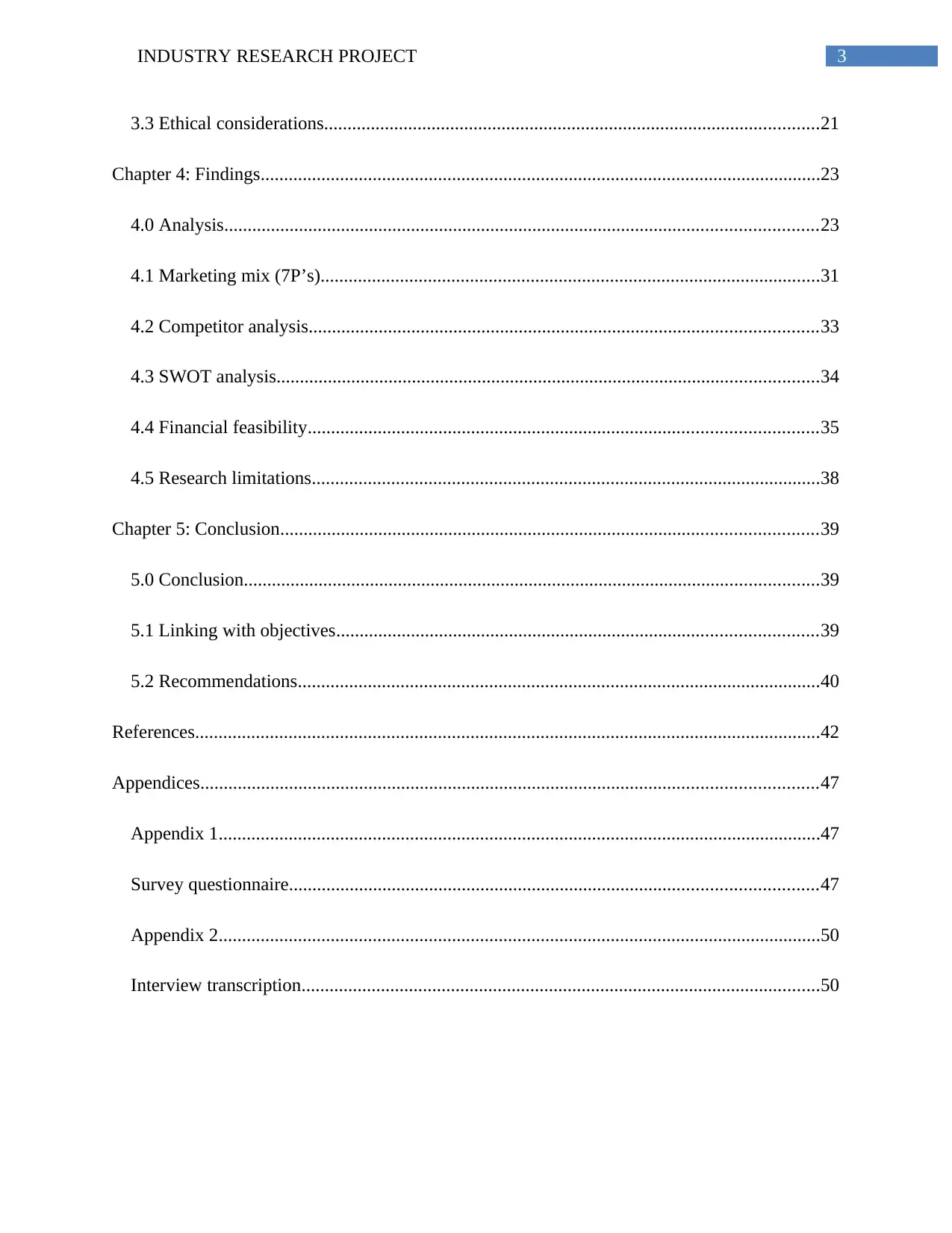
3INDUSTRY RESEARCH PROJECT
3.3 Ethical considerations..........................................................................................................21
Chapter 4: Findings........................................................................................................................23
4.0 Analysis...............................................................................................................................23
4.1 Marketing mix (7P’s)...........................................................................................................31
4.2 Competitor analysis.............................................................................................................33
4.3 SWOT analysis....................................................................................................................34
4.4 Financial feasibility.............................................................................................................35
4.5 Research limitations.............................................................................................................38
Chapter 5: Conclusion...................................................................................................................39
5.0 Conclusion...........................................................................................................................39
5.1 Linking with objectives.......................................................................................................39
5.2 Recommendations................................................................................................................40
References......................................................................................................................................42
Appendices....................................................................................................................................47
Appendix 1.................................................................................................................................47
Survey questionnaire.................................................................................................................47
Appendix 2.................................................................................................................................50
Interview transcription...............................................................................................................50
3.3 Ethical considerations..........................................................................................................21
Chapter 4: Findings........................................................................................................................23
4.0 Analysis...............................................................................................................................23
4.1 Marketing mix (7P’s)...........................................................................................................31
4.2 Competitor analysis.............................................................................................................33
4.3 SWOT analysis....................................................................................................................34
4.4 Financial feasibility.............................................................................................................35
4.5 Research limitations.............................................................................................................38
Chapter 5: Conclusion...................................................................................................................39
5.0 Conclusion...........................................................................................................................39
5.1 Linking with objectives.......................................................................................................39
5.2 Recommendations................................................................................................................40
References......................................................................................................................................42
Appendices....................................................................................................................................47
Appendix 1.................................................................................................................................47
Survey questionnaire.................................................................................................................47
Appendix 2.................................................................................................................................50
Interview transcription...............................................................................................................50
Paraphrase This Document
Need a fresh take? Get an instant paraphrase of this document with our AI Paraphraser
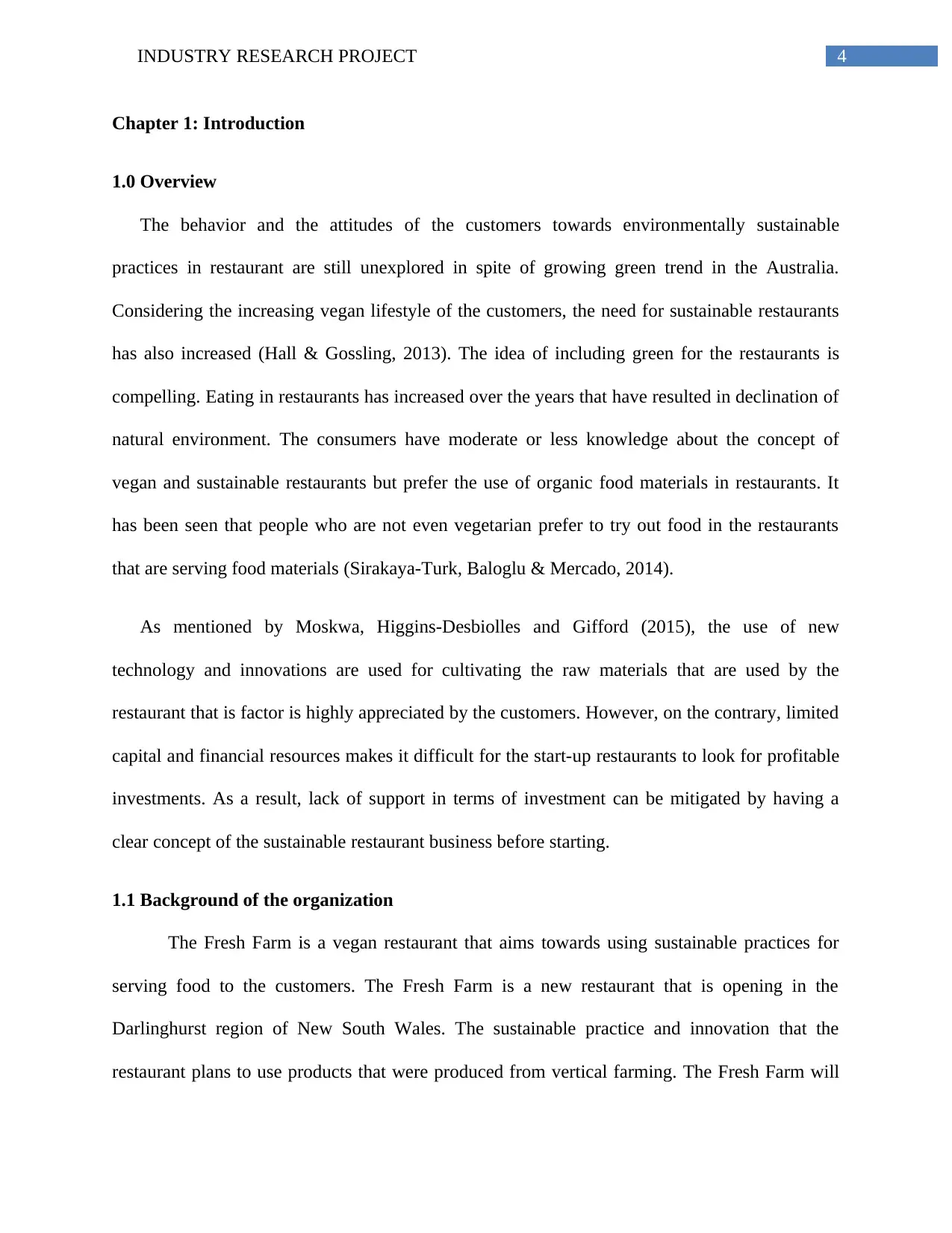
4INDUSTRY RESEARCH PROJECT
Chapter 1: Introduction
1.0 Overview
The behavior and the attitudes of the customers towards environmentally sustainable
practices in restaurant are still unexplored in spite of growing green trend in the Australia.
Considering the increasing vegan lifestyle of the customers, the need for sustainable restaurants
has also increased (Hall & Gossling, 2013). The idea of including green for the restaurants is
compelling. Eating in restaurants has increased over the years that have resulted in declination of
natural environment. The consumers have moderate or less knowledge about the concept of
vegan and sustainable restaurants but prefer the use of organic food materials in restaurants. It
has been seen that people who are not even vegetarian prefer to try out food in the restaurants
that are serving food materials (Sirakaya-Turk, Baloglu & Mercado, 2014).
As mentioned by Moskwa, Higgins-Desbiolles and Gifford (2015), the use of new
technology and innovations are used for cultivating the raw materials that are used by the
restaurant that is factor is highly appreciated by the customers. However, on the contrary, limited
capital and financial resources makes it difficult for the start-up restaurants to look for profitable
investments. As a result, lack of support in terms of investment can be mitigated by having a
clear concept of the sustainable restaurant business before starting.
1.1 Background of the organization
The Fresh Farm is a vegan restaurant that aims towards using sustainable practices for
serving food to the customers. The Fresh Farm is a new restaurant that is opening in the
Darlinghurst region of New South Wales. The sustainable practice and innovation that the
restaurant plans to use products that were produced from vertical farming. The Fresh Farm will
Chapter 1: Introduction
1.0 Overview
The behavior and the attitudes of the customers towards environmentally sustainable
practices in restaurant are still unexplored in spite of growing green trend in the Australia.
Considering the increasing vegan lifestyle of the customers, the need for sustainable restaurants
has also increased (Hall & Gossling, 2013). The idea of including green for the restaurants is
compelling. Eating in restaurants has increased over the years that have resulted in declination of
natural environment. The consumers have moderate or less knowledge about the concept of
vegan and sustainable restaurants but prefer the use of organic food materials in restaurants. It
has been seen that people who are not even vegetarian prefer to try out food in the restaurants
that are serving food materials (Sirakaya-Turk, Baloglu & Mercado, 2014).
As mentioned by Moskwa, Higgins-Desbiolles and Gifford (2015), the use of new
technology and innovations are used for cultivating the raw materials that are used by the
restaurant that is factor is highly appreciated by the customers. However, on the contrary, limited
capital and financial resources makes it difficult for the start-up restaurants to look for profitable
investments. As a result, lack of support in terms of investment can be mitigated by having a
clear concept of the sustainable restaurant business before starting.
1.1 Background of the organization
The Fresh Farm is a vegan restaurant that aims towards using sustainable practices for
serving food to the customers. The Fresh Farm is a new restaurant that is opening in the
Darlinghurst region of New South Wales. The sustainable practice and innovation that the
restaurant plans to use products that were produced from vertical farming. The Fresh Farm will
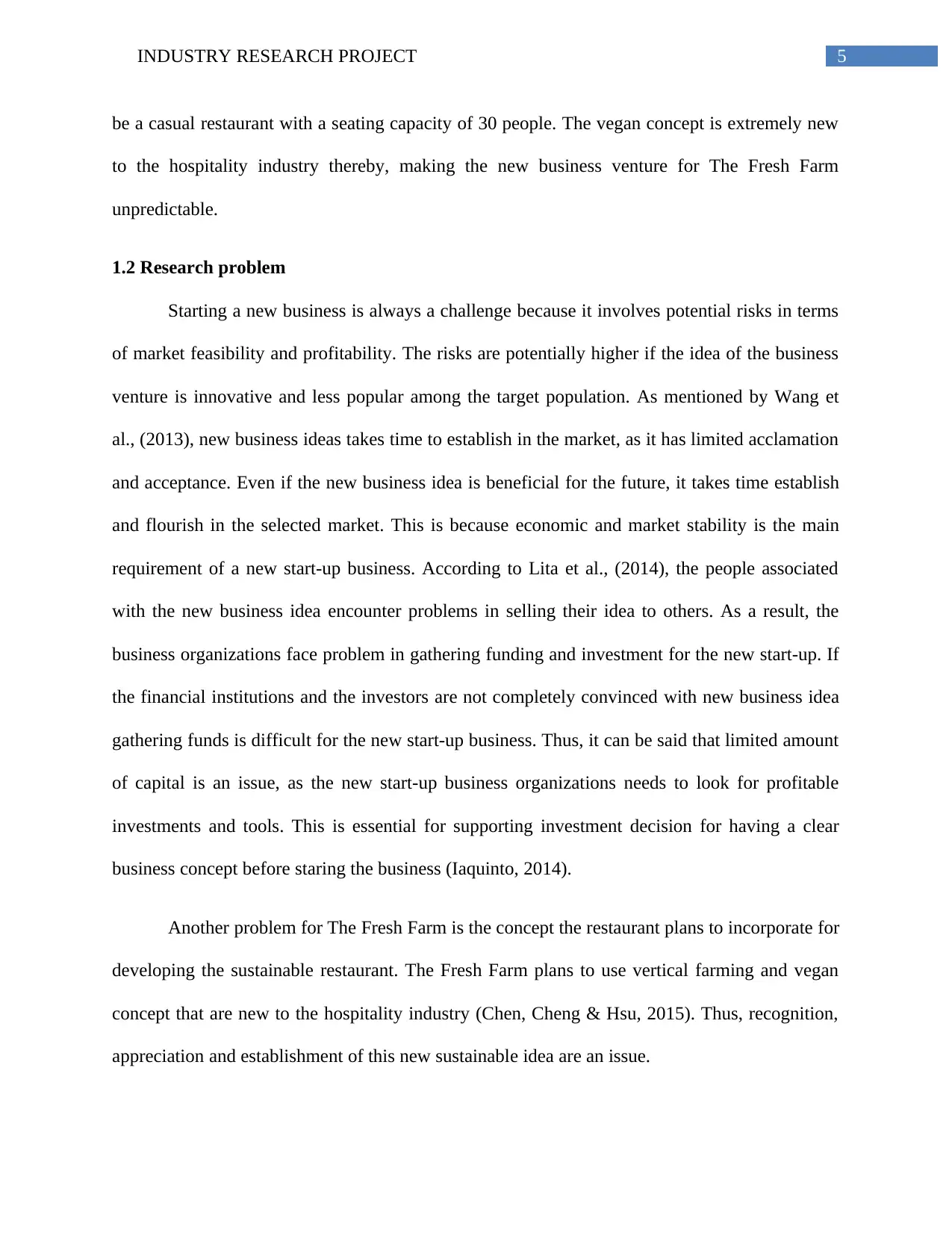
5INDUSTRY RESEARCH PROJECT
be a casual restaurant with a seating capacity of 30 people. The vegan concept is extremely new
to the hospitality industry thereby, making the new business venture for The Fresh Farm
unpredictable.
1.2 Research problem
Starting a new business is always a challenge because it involves potential risks in terms
of market feasibility and profitability. The risks are potentially higher if the idea of the business
venture is innovative and less popular among the target population. As mentioned by Wang et
al., (2013), new business ideas takes time to establish in the market, as it has limited acclamation
and acceptance. Even if the new business idea is beneficial for the future, it takes time establish
and flourish in the selected market. This is because economic and market stability is the main
requirement of a new start-up business. According to Lita et al., (2014), the people associated
with the new business idea encounter problems in selling their idea to others. As a result, the
business organizations face problem in gathering funding and investment for the new start-up. If
the financial institutions and the investors are not completely convinced with new business idea
gathering funds is difficult for the new start-up business. Thus, it can be said that limited amount
of capital is an issue, as the new start-up business organizations needs to look for profitable
investments and tools. This is essential for supporting investment decision for having a clear
business concept before staring the business (Iaquinto, 2014).
Another problem for The Fresh Farm is the concept the restaurant plans to incorporate for
developing the sustainable restaurant. The Fresh Farm plans to use vertical farming and vegan
concept that are new to the hospitality industry (Chen, Cheng & Hsu, 2015). Thus, recognition,
appreciation and establishment of this new sustainable idea are an issue.
be a casual restaurant with a seating capacity of 30 people. The vegan concept is extremely new
to the hospitality industry thereby, making the new business venture for The Fresh Farm
unpredictable.
1.2 Research problem
Starting a new business is always a challenge because it involves potential risks in terms
of market feasibility and profitability. The risks are potentially higher if the idea of the business
venture is innovative and less popular among the target population. As mentioned by Wang et
al., (2013), new business ideas takes time to establish in the market, as it has limited acclamation
and acceptance. Even if the new business idea is beneficial for the future, it takes time establish
and flourish in the selected market. This is because economic and market stability is the main
requirement of a new start-up business. According to Lita et al., (2014), the people associated
with the new business idea encounter problems in selling their idea to others. As a result, the
business organizations face problem in gathering funding and investment for the new start-up. If
the financial institutions and the investors are not completely convinced with new business idea
gathering funds is difficult for the new start-up business. Thus, it can be said that limited amount
of capital is an issue, as the new start-up business organizations needs to look for profitable
investments and tools. This is essential for supporting investment decision for having a clear
business concept before staring the business (Iaquinto, 2014).
Another problem for The Fresh Farm is the concept the restaurant plans to incorporate for
developing the sustainable restaurant. The Fresh Farm plans to use vertical farming and vegan
concept that are new to the hospitality industry (Chen, Cheng & Hsu, 2015). Thus, recognition,
appreciation and establishment of this new sustainable idea are an issue.
⊘ This is a preview!⊘
Do you want full access?
Subscribe today to unlock all pages.

Trusted by 1+ million students worldwide
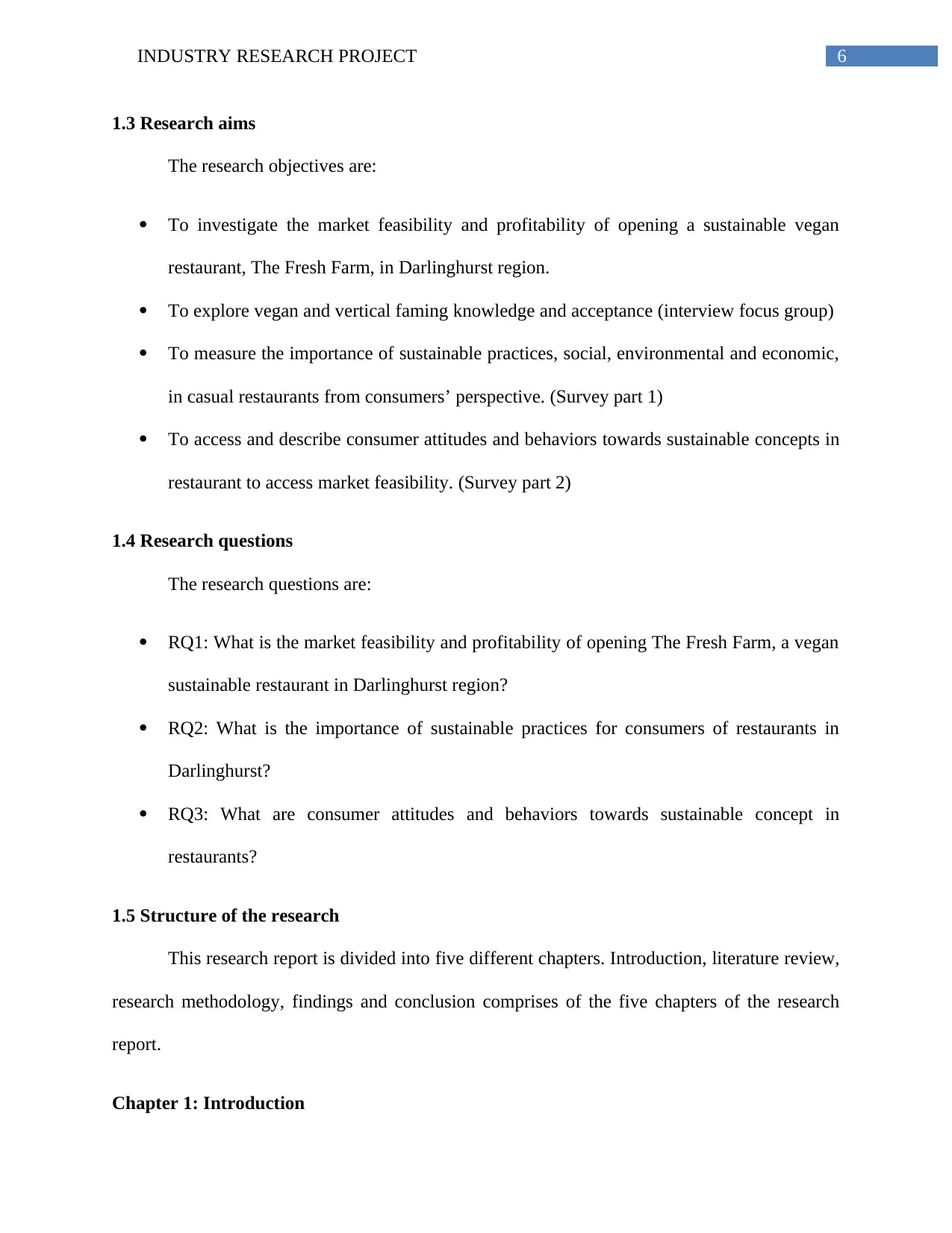
6INDUSTRY RESEARCH PROJECT
1.3 Research aims
The research objectives are:
To investigate the market feasibility and profitability of opening a sustainable vegan
restaurant, The Fresh Farm, in Darlinghurst region.
To explore vegan and vertical faming knowledge and acceptance (interview focus group)
To measure the importance of sustainable practices, social, environmental and economic,
in casual restaurants from consumers’ perspective. (Survey part 1)
To access and describe consumer attitudes and behaviors towards sustainable concepts in
restaurant to access market feasibility. (Survey part 2)
1.4 Research questions
The research questions are:
RQ1: What is the market feasibility and profitability of opening The Fresh Farm, a vegan
sustainable restaurant in Darlinghurst region?
RQ2: What is the importance of sustainable practices for consumers of restaurants in
Darlinghurst?
RQ3: What are consumer attitudes and behaviors towards sustainable concept in
restaurants?
1.5 Structure of the research
This research report is divided into five different chapters. Introduction, literature review,
research methodology, findings and conclusion comprises of the five chapters of the research
report.
Chapter 1: Introduction
1.3 Research aims
The research objectives are:
To investigate the market feasibility and profitability of opening a sustainable vegan
restaurant, The Fresh Farm, in Darlinghurst region.
To explore vegan and vertical faming knowledge and acceptance (interview focus group)
To measure the importance of sustainable practices, social, environmental and economic,
in casual restaurants from consumers’ perspective. (Survey part 1)
To access and describe consumer attitudes and behaviors towards sustainable concepts in
restaurant to access market feasibility. (Survey part 2)
1.4 Research questions
The research questions are:
RQ1: What is the market feasibility and profitability of opening The Fresh Farm, a vegan
sustainable restaurant in Darlinghurst region?
RQ2: What is the importance of sustainable practices for consumers of restaurants in
Darlinghurst?
RQ3: What are consumer attitudes and behaviors towards sustainable concept in
restaurants?
1.5 Structure of the research
This research report is divided into five different chapters. Introduction, literature review,
research methodology, findings and conclusion comprises of the five chapters of the research
report.
Chapter 1: Introduction
Paraphrase This Document
Need a fresh take? Get an instant paraphrase of this document with our AI Paraphraser
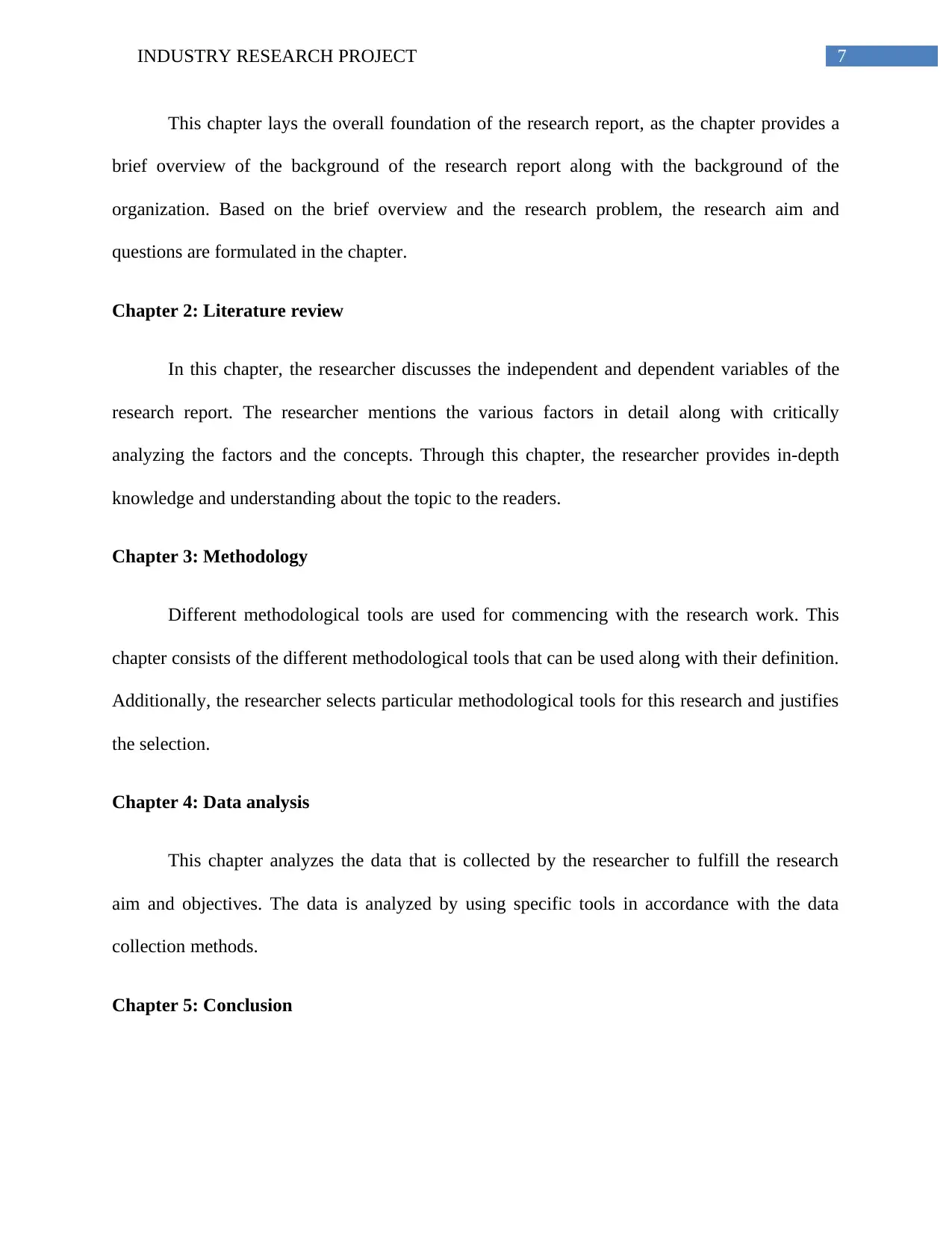
7INDUSTRY RESEARCH PROJECT
This chapter lays the overall foundation of the research report, as the chapter provides a
brief overview of the background of the research report along with the background of the
organization. Based on the brief overview and the research problem, the research aim and
questions are formulated in the chapter.
Chapter 2: Literature review
In this chapter, the researcher discusses the independent and dependent variables of the
research report. The researcher mentions the various factors in detail along with critically
analyzing the factors and the concepts. Through this chapter, the researcher provides in-depth
knowledge and understanding about the topic to the readers.
Chapter 3: Methodology
Different methodological tools are used for commencing with the research work. This
chapter consists of the different methodological tools that can be used along with their definition.
Additionally, the researcher selects particular methodological tools for this research and justifies
the selection.
Chapter 4: Data analysis
This chapter analyzes the data that is collected by the researcher to fulfill the research
aim and objectives. The data is analyzed by using specific tools in accordance with the data
collection methods.
Chapter 5: Conclusion
This chapter lays the overall foundation of the research report, as the chapter provides a
brief overview of the background of the research report along with the background of the
organization. Based on the brief overview and the research problem, the research aim and
questions are formulated in the chapter.
Chapter 2: Literature review
In this chapter, the researcher discusses the independent and dependent variables of the
research report. The researcher mentions the various factors in detail along with critically
analyzing the factors and the concepts. Through this chapter, the researcher provides in-depth
knowledge and understanding about the topic to the readers.
Chapter 3: Methodology
Different methodological tools are used for commencing with the research work. This
chapter consists of the different methodological tools that can be used along with their definition.
Additionally, the researcher selects particular methodological tools for this research and justifies
the selection.
Chapter 4: Data analysis
This chapter analyzes the data that is collected by the researcher to fulfill the research
aim and objectives. The data is analyzed by using specific tools in accordance with the data
collection methods.
Chapter 5: Conclusion

8INDUSTRY RESEARCH PROJECT
The last chapter deduces the conclusion of the entire research report by identifying the
gap, reason for the gap from the view of the respondents and providing suitable solutions to the
gap.
The last chapter deduces the conclusion of the entire research report by identifying the
gap, reason for the gap from the view of the respondents and providing suitable solutions to the
gap.
⊘ This is a preview!⊘
Do you want full access?
Subscribe today to unlock all pages.

Trusted by 1+ million students worldwide
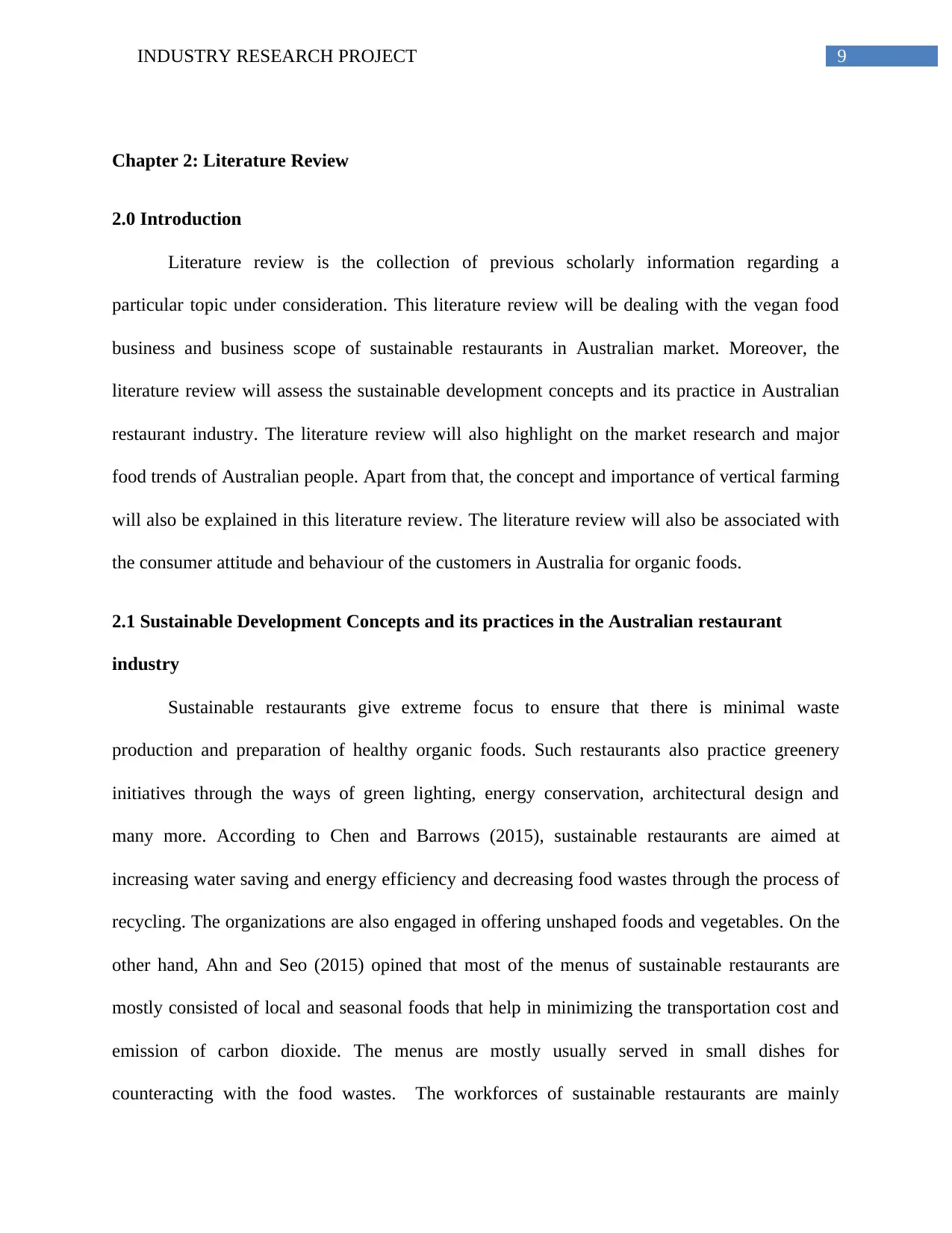
9INDUSTRY RESEARCH PROJECT
Chapter 2: Literature Review
2.0 Introduction
Literature review is the collection of previous scholarly information regarding a
particular topic under consideration. This literature review will be dealing with the vegan food
business and business scope of sustainable restaurants in Australian market. Moreover, the
literature review will assess the sustainable development concepts and its practice in Australian
restaurant industry. The literature review will also highlight on the market research and major
food trends of Australian people. Apart from that, the concept and importance of vertical farming
will also be explained in this literature review. The literature review will also be associated with
the consumer attitude and behaviour of the customers in Australia for organic foods.
2.1 Sustainable Development Concepts and its practices in the Australian restaurant
industry
Sustainable restaurants give extreme focus to ensure that there is minimal waste
production and preparation of healthy organic foods. Such restaurants also practice greenery
initiatives through the ways of green lighting, energy conservation, architectural design and
many more. According to Chen and Barrows (2015), sustainable restaurants are aimed at
increasing water saving and energy efficiency and decreasing food wastes through the process of
recycling. The organizations are also engaged in offering unshaped foods and vegetables. On the
other hand, Ahn and Seo (2015) opined that most of the menus of sustainable restaurants are
mostly consisted of local and seasonal foods that help in minimizing the transportation cost and
emission of carbon dioxide. The menus are mostly usually served in small dishes for
counteracting with the food wastes. The workforces of sustainable restaurants are mainly
Chapter 2: Literature Review
2.0 Introduction
Literature review is the collection of previous scholarly information regarding a
particular topic under consideration. This literature review will be dealing with the vegan food
business and business scope of sustainable restaurants in Australian market. Moreover, the
literature review will assess the sustainable development concepts and its practice in Australian
restaurant industry. The literature review will also highlight on the market research and major
food trends of Australian people. Apart from that, the concept and importance of vertical farming
will also be explained in this literature review. The literature review will also be associated with
the consumer attitude and behaviour of the customers in Australia for organic foods.
2.1 Sustainable Development Concepts and its practices in the Australian restaurant
industry
Sustainable restaurants give extreme focus to ensure that there is minimal waste
production and preparation of healthy organic foods. Such restaurants also practice greenery
initiatives through the ways of green lighting, energy conservation, architectural design and
many more. According to Chen and Barrows (2015), sustainable restaurants are aimed at
increasing water saving and energy efficiency and decreasing food wastes through the process of
recycling. The organizations are also engaged in offering unshaped foods and vegetables. On the
other hand, Ahn and Seo (2015) opined that most of the menus of sustainable restaurants are
mostly consisted of local and seasonal foods that help in minimizing the transportation cost and
emission of carbon dioxide. The menus are mostly usually served in small dishes for
counteracting with the food wastes. The workforces of sustainable restaurants are mainly
Paraphrase This Document
Need a fresh take? Get an instant paraphrase of this document with our AI Paraphraser
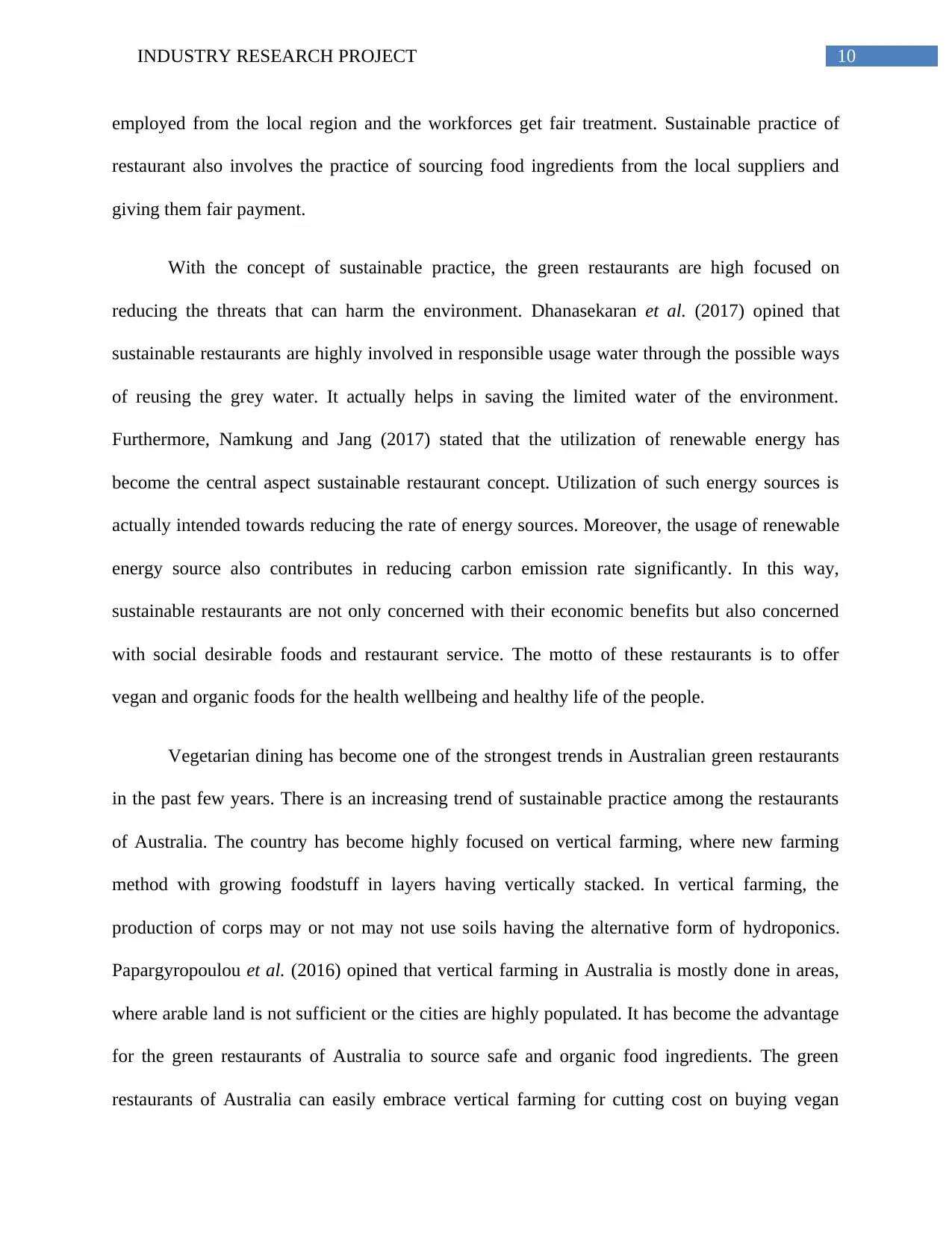
10INDUSTRY RESEARCH PROJECT
employed from the local region and the workforces get fair treatment. Sustainable practice of
restaurant also involves the practice of sourcing food ingredients from the local suppliers and
giving them fair payment.
With the concept of sustainable practice, the green restaurants are high focused on
reducing the threats that can harm the environment. Dhanasekaran et al. (2017) opined that
sustainable restaurants are highly involved in responsible usage water through the possible ways
of reusing the grey water. It actually helps in saving the limited water of the environment.
Furthermore, Namkung and Jang (2017) stated that the utilization of renewable energy has
become the central aspect sustainable restaurant concept. Utilization of such energy sources is
actually intended towards reducing the rate of energy sources. Moreover, the usage of renewable
energy source also contributes in reducing carbon emission rate significantly. In this way,
sustainable restaurants are not only concerned with their economic benefits but also concerned
with social desirable foods and restaurant service. The motto of these restaurants is to offer
vegan and organic foods for the health wellbeing and healthy life of the people.
Vegetarian dining has become one of the strongest trends in Australian green restaurants
in the past few years. There is an increasing trend of sustainable practice among the restaurants
of Australia. The country has become highly focused on vertical farming, where new farming
method with growing foodstuff in layers having vertically stacked. In vertical farming, the
production of corps may or not may not use soils having the alternative form of hydroponics.
Papargyropoulou et al. (2016) opined that vertical farming in Australia is mostly done in areas,
where arable land is not sufficient or the cities are highly populated. It has become the advantage
for the green restaurants of Australia to source safe and organic food ingredients. The green
restaurants of Australia can easily embrace vertical farming for cutting cost on buying vegan
employed from the local region and the workforces get fair treatment. Sustainable practice of
restaurant also involves the practice of sourcing food ingredients from the local suppliers and
giving them fair payment.
With the concept of sustainable practice, the green restaurants are high focused on
reducing the threats that can harm the environment. Dhanasekaran et al. (2017) opined that
sustainable restaurants are highly involved in responsible usage water through the possible ways
of reusing the grey water. It actually helps in saving the limited water of the environment.
Furthermore, Namkung and Jang (2017) stated that the utilization of renewable energy has
become the central aspect sustainable restaurant concept. Utilization of such energy sources is
actually intended towards reducing the rate of energy sources. Moreover, the usage of renewable
energy source also contributes in reducing carbon emission rate significantly. In this way,
sustainable restaurants are not only concerned with their economic benefits but also concerned
with social desirable foods and restaurant service. The motto of these restaurants is to offer
vegan and organic foods for the health wellbeing and healthy life of the people.
Vegetarian dining has become one of the strongest trends in Australian green restaurants
in the past few years. There is an increasing trend of sustainable practice among the restaurants
of Australia. The country has become highly focused on vertical farming, where new farming
method with growing foodstuff in layers having vertically stacked. In vertical farming, the
production of corps may or not may not use soils having the alternative form of hydroponics.
Papargyropoulou et al. (2016) opined that vertical farming in Australia is mostly done in areas,
where arable land is not sufficient or the cities are highly populated. It has become the advantage
for the green restaurants of Australia to source safe and organic food ingredients. The green
restaurants of Australia can easily embrace vertical farming for cutting cost on buying vegan
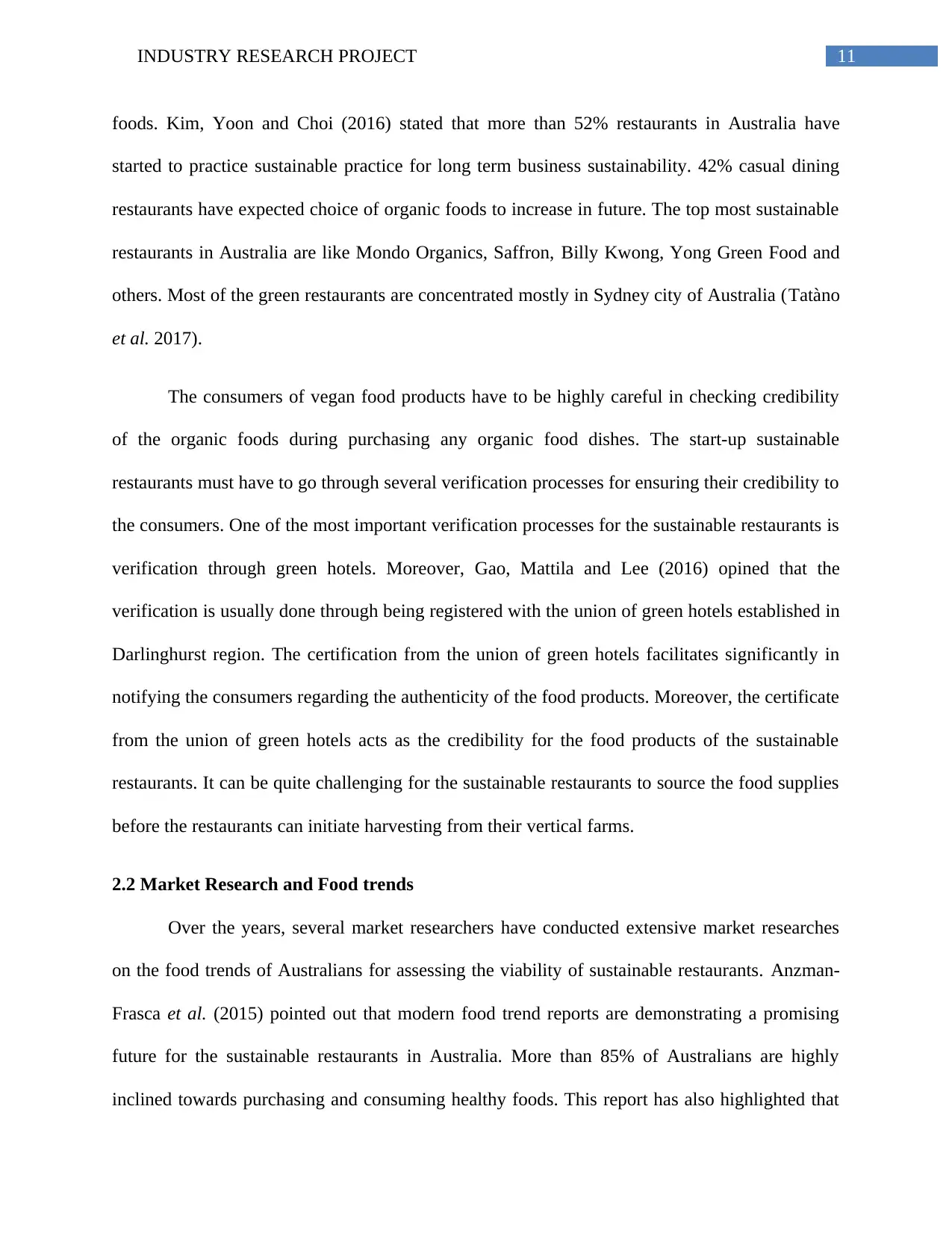
11INDUSTRY RESEARCH PROJECT
foods. Kim, Yoon and Choi (2016) stated that more than 52% restaurants in Australia have
started to practice sustainable practice for long term business sustainability. 42% casual dining
restaurants have expected choice of organic foods to increase in future. The top most sustainable
restaurants in Australia are like Mondo Organics, Saffron, Billy Kwong, Yong Green Food and
others. Most of the green restaurants are concentrated mostly in Sydney city of Australia (Tatàno
et al. 2017).
The consumers of vegan food products have to be highly careful in checking credibility
of the organic foods during purchasing any organic food dishes. The start-up sustainable
restaurants must have to go through several verification processes for ensuring their credibility to
the consumers. One of the most important verification processes for the sustainable restaurants is
verification through green hotels. Moreover, Gao, Mattila and Lee (2016) opined that the
verification is usually done through being registered with the union of green hotels established in
Darlinghurst region. The certification from the union of green hotels facilitates significantly in
notifying the consumers regarding the authenticity of the food products. Moreover, the certificate
from the union of green hotels acts as the credibility for the food products of the sustainable
restaurants. It can be quite challenging for the sustainable restaurants to source the food supplies
before the restaurants can initiate harvesting from their vertical farms.
2.2 Market Research and Food trends
Over the years, several market researchers have conducted extensive market researches
on the food trends of Australians for assessing the viability of sustainable restaurants. Anzman-
Frasca et al. (2015) pointed out that modern food trend reports are demonstrating a promising
future for the sustainable restaurants in Australia. More than 85% of Australians are highly
inclined towards purchasing and consuming healthy foods. This report has also highlighted that
foods. Kim, Yoon and Choi (2016) stated that more than 52% restaurants in Australia have
started to practice sustainable practice for long term business sustainability. 42% casual dining
restaurants have expected choice of organic foods to increase in future. The top most sustainable
restaurants in Australia are like Mondo Organics, Saffron, Billy Kwong, Yong Green Food and
others. Most of the green restaurants are concentrated mostly in Sydney city of Australia (Tatàno
et al. 2017).
The consumers of vegan food products have to be highly careful in checking credibility
of the organic foods during purchasing any organic food dishes. The start-up sustainable
restaurants must have to go through several verification processes for ensuring their credibility to
the consumers. One of the most important verification processes for the sustainable restaurants is
verification through green hotels. Moreover, Gao, Mattila and Lee (2016) opined that the
verification is usually done through being registered with the union of green hotels established in
Darlinghurst region. The certification from the union of green hotels facilitates significantly in
notifying the consumers regarding the authenticity of the food products. Moreover, the certificate
from the union of green hotels acts as the credibility for the food products of the sustainable
restaurants. It can be quite challenging for the sustainable restaurants to source the food supplies
before the restaurants can initiate harvesting from their vertical farms.
2.2 Market Research and Food trends
Over the years, several market researchers have conducted extensive market researches
on the food trends of Australians for assessing the viability of sustainable restaurants. Anzman-
Frasca et al. (2015) pointed out that modern food trend reports are demonstrating a promising
future for the sustainable restaurants in Australia. More than 85% of Australians are highly
inclined towards purchasing and consuming healthy foods. This report has also highlighted that
⊘ This is a preview!⊘
Do you want full access?
Subscribe today to unlock all pages.

Trusted by 1+ million students worldwide
1 out of 53
Your All-in-One AI-Powered Toolkit for Academic Success.
+13062052269
info@desklib.com
Available 24*7 on WhatsApp / Email
![[object Object]](/_next/static/media/star-bottom.7253800d.svg)
Unlock your academic potential
Copyright © 2020–2025 A2Z Services. All Rights Reserved. Developed and managed by ZUCOL.


